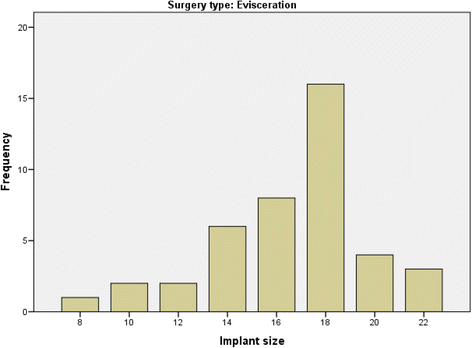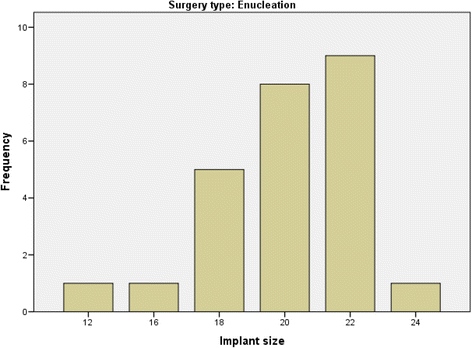Enucleation and evisceration at a tertiary care hospital in a developing country
- PMID: 26362425
- PMCID: PMC4566484
- DOI: 10.1186/s12886-015-0108-x
Enucleation and evisceration at a tertiary care hospital in a developing country
Abstract
Background: To analyze the demographics, indications, and surgical outcomes of anophthalmic surgery (enucleation and evisceration) at Jordan University Hospital during a 5-year period.
Methods: We conducted a retrospective chart review of patients who had undergone evisceration or enucleation between August 2006 and June 2011. The data collected included age at time of surgery, sex, affected eye, surgical indication, implant size, and postoperative complications.
Results: Anophthalmic surgery was performed for 68 eyes of 67 patients during the study period (42 (62 %) eviscerations and 26 (38 %) enucleations). Forty-three patients (64 %) were men, and 40 (59 %) eyes were right eyes. Trauma was the leading cause for anophthalmic surgery in 40 % of cases followed by a blind painful eye secondary to glaucoma (19 %) in the enucleation group and endophthalmitis (28.6 %) in the evisceration group. The most common anophthalmic surgery complication was wound dehiscence in 11.5 % of patients in the enucleation and 9.5 % in the evisceration groups. The mean and median sizes of the implants for evisceration were 16.6 and 18.0 mm, respectively; for enucleation, both were 20 mm.
Conclusions: Evisceration was the preferred anophthalmic surgery in our series unless contraindicated. Trauma was the most common predisposing factor for evisceration and enucleation in our tertiary care center followed by blind painful eyes and endophthalmitis. The most common complication was wound dehiscence in both groups.
Figures
References
MeSH terms
LinkOut - more resources
Full Text Sources
Other Literature Sources



